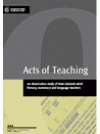This research study of how literacy, numeracy and language (LNL)1 teachers actually teach is the first of its kind in New Zealand , and one of a small number internationally. It is part of a growing body of research in this area (Benseman, 2003).
The purpose of this study was to start the process of exploring literacy, numeracy and language teaching by observing how 15 tutors in a cross-section of LNL contexts actually teach their students these skills. The results of this study should not be taken as a definitive study where the results can be generalised to all literacy, numeracy and language teachers in New Zealand . Rather, as an exploratory study involving only a small number of teachers and limited observation durations, it is intended to give a glimpse into what probably goes on in a reasonable number of these classrooms. As such, we hope that the findings will provoke debate not only about whether or not our findings are truly indicative of literacy, numeracy and language provision, but more importantly, what literacy, numeracy and language teachers should be doing as teachers. In relation to this latter point, readers are directed to the literature review (Benseman, Sutton, & Lander, 2005) on effective literacy, numeracy and language teaching completed in conjunction with this study. Where appropriate, results from this literature review have been included in the discussion of the findings from our study.
Key Results
Teacher status and background
- teachers were predominantly female, aged 40+ years and Pakeha
- they held a wide range of qualifications, including school teaching qualifications, but only a small number held LNL-specific or adult education qualifications
- there were wide variations in the amount of teaching they did per week and the time they spent on preparation
- they had been able to attend variable amounts of professional development over the previous year
- some of their teaching positions had less than ideal conditions.
Physical environment and teaching resources
- there were wide variation in the physical environment and teacher resources available, from good to much less than ideal
- computers were widely available, but were mainly used for word-processing rather than computer-aided teaching
Generic teaching
- all teachers had created positive, supportive learning environment and they had a high level of commitment to the welfare of their learners
- teachers talked much more than learners(up to 60% of the time), even in classes
- questioning plays a very prominent role in the teaching process; however, teachers mostly asked ‘closed’ questions and did not use questions as scaffolds for further teaching
- there was some evidence of teaching meta-cognitive skills and limited amounts of sustained discussion or debate
Forms of provision
- considerable variations were observed in the length of programmes, the amount of teaching per week and the actual amount of literacy teaching that took place within programmes
- teachers used ‘authentic’ curricula, largely in terms of them choosing content that was adult-appropriate and topical; there was little evidence of learner-directed content
- there were wide variations in the amount of LNL teaching that observed in integrated programmes
- 1:1 and group teaching both have distinctive, positive features
Teaching of LNL skills
- only a limited number of deliberate acts of reading teaching were observed by researchers
- most teachers used a relatively small range of teaching methods
- most spelling was taught incidentally and was closely linked to teaching of reading
- miscues were rarely used as teaching opportunities when learners were reading
- numeracy teaching was clearly linked to diagnosed learning needs and numeracy tasks were graded to match learners’ skills
- researchers observed only a few sessions where writing was taught; teachers said they found the teaching of writing difficult and that writing was often left out of teaching sessions to make room for other activities
- teachers appeared to use the same teaching strategies for ESOL as for others for whom English was a first language
- speaking and listening skills were seen as important means of building social and personal skills and were interspersed with the teaching of other skills.

